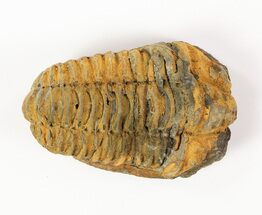This Specimen has been sold.
Lines of Twelve Lonchodomas Trilobites - Migrating Behavior?
This is a really cool trilobite plate. It contains two perpendicular lines of twelve Lonchodomas trilobites (and one Colpocoryphe) from the Lower Fezouata Formation of Morocco. It has been hypothesized that the lines of trilobites from this locality might represent migratory behavior. A paper was published a couple years back, describing similar fossils from this same locality.
480-million-year-old trilobite ‘traffic jams’ may reveal ancient migratory behavior
The rock measures 13 x 7" with the largest trilobite being 2.7" long. Total restoration on this piece is less than 1% with just a few touchups on the trilobite spines.
Lonchodomas, formerly Ampyx, has a distinctive, elongated rostrum and sweeping genal spines, which may have both helped to deter predators as well as providing more surface area to keep it on top of the mud.
480-million-year-old trilobite ‘traffic jams’ may reveal ancient migratory behavior
The rock measures 13 x 7" with the largest trilobite being 2.7" long. Total restoration on this piece is less than 1% with just a few touchups on the trilobite spines.
Lonchodomas, formerly Ampyx, has a distinctive, elongated rostrum and sweeping genal spines, which may have both helped to deter predators as well as providing more surface area to keep it on top of the mud.
About Trilobites
Trilobites are an extinct class of marine arthropods that thrived for nearly 270 million years, from the early Cambrian to the end of the Permian period (around 521 to 252 million years ago). They are one of the most successful and diverse groups in the history of life, with over 25,000 described species spanning a wide range of sizes, shapes, and ecological niches. Known for their distinctive, segmented exoskeletons, trilobites provide invaluable insights into the evolutionary history of arthropods and the dynamics of ancient marine ecosystems.
Trilobites are an extinct class of marine arthropods that thrived for nearly 270 million years, from the early Cambrian to the end of the Permian period (around 521 to 252 million years ago). They are one of the most successful and diverse groups in the history of life, with over 25,000 described species spanning a wide range of sizes, shapes, and ecological niches. Known for their distinctive, segmented exoskeletons, trilobites provide invaluable insights into the evolutionary history of arthropods and the dynamics of ancient marine ecosystems.
SPECIES
Lonchodomas sp & Colpocoryphe sp.
AGE
LOCATION
Ouled Slimane, Zagora area, Morocco
FORMATION
Lower Fezouata Formation
SIZE
Rock 13 x 7" , Longest Trilobite 2.7"
CATEGORY
SUB CATEGORY
ITEM
#312824
We guarantee the authenticity of all of our specimens.
 Reviews
Reviews















